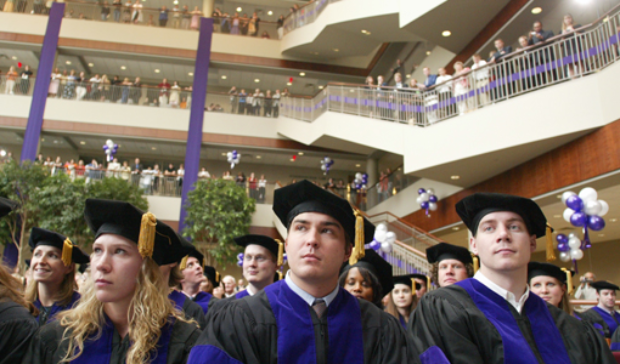Last year, the Collaboration for the Advancement of College Teaching sponsored a conference on “Learning Through Discovery: The Power of Inquiry.” For the past three years at St. Thomas, funds from a Bush Foundation program grant have supported more than 70 faculty projects on inquiry-based instruction as a means of improving students’ higher order thinking skills. As co-director of the grant program, I knew that St. Thomas had a lot to offer.
I teach geography and became convinced a few years ago that the best way to teach students was to have them solve real problems, just the way professionals do. Rather than plod through Chapter 1 in the first week and Chapter 2 in the second, we get a real client with a real problem. The clients come to class, explain their needs and then we work on the problem for a month or so. The client returns, students present what they’ve done, and clients tell them if it solves their problem.
For example, last year one class had The Bibelot Shops as a client. Bibelot wanted the class to evaluate a new store site in Woodbury, and to construct demographic profiles of the customers at its four existing stores. We do about 50 real projects a year, such as mapping voting patterns in suburbs, making maps and a family tree to help explain to a judge that two Burmese Karen Christians would be endangered if deported and calculating housing units and median income in Merriam Park.
Thinking about the conference, I called my friend, Dr. Sue Chaplin, a professor of biology at St. Thomas. She is a fabulous teacher, never afraid of innovations.
Chaplin is especially interested in how to make science interesting and accessible to nonmajors and introductory students. She belongs to Project Kaleidoscope, which is dedicated to science education reform. One good technique is teaching content in the context of real-world problems. Two years ago she taught a human biology course, led by problems instead of chapter topics: (“Want fries with that cheeseburger?), work and fitness (“Can you climb Mt. Everest?), immunity (“Is HIV an epidemic?”), and reproductive health (“Whose baby is this?”). Each unit had a central case (the problem or issue), around which lectures, discussions and homework were focused.
Principles and content are still taught and are still of central importance, but they are presented in the context of their use, rather than just memorized.
Chaplin found a highly significant increase in students’ positive response to the statement “Biology is an interesting subject to me,” with five times as many students responding in the “strongly agree” category at the end of the semester.
At that conference on inquiry-based learning, Chaplin and I asked how professors know their students are thinking instead of just applying plug-and-play procedures. We modeled inquiry learning.
Following a brief introduction to levels of higher-order thinking (knowledge, comprehension, application, analysis, synthesis, evaluation), we gave 45 fellow teachers a reading about famine in the Horn of Africa from The Economist. They first identified what they would want their students to learn, then assigned levels of higher-order thinking to each objective. For example, if a teacher wanted students to identify where famine occurred, simple memorization would be sufficient. If the teacher wanted students to identify the causes of famine in the region, only reading comprehension would be required.
However, if a teacher wanted students to explain why food production has declined in the area, students would have to investigate political conditions, weather, the role of poorly developed infrastructure and much more. This would require research skills, analysis, synthesis of multiple sources and expression of their conclusions, which would emphasize successively higher orders of thinking.
During the presentation, Chaplin demonstrated how to develop assignments that would assess specific thinking skills. For example, most high school students taking college biology for the first time can recite (from memory) the basic characteristics that define “life.” Chaplin asks students to work together to debate whether computers are alive, based on the characteristics of life they mutually agree upon. They read original articles, each proposing an alternative hypothesis for the origin of life on earth. After students discuss each of the hypotheses they write a consensus essay to answer the question, “Could life originate on earth today?”
Working on new, relevant problems keeps a course fresh and energizes the instructor as well as the students. Students appreciate the experience of learning as it really is – messy and imperfect, but something they can do and hopefully will do throughout their lives.
Dr. Robert Werner has a Ph.D. from the University of Minnesota and came to St. Thomas in 1991. Dr. Sue Chaplin, a Ph.D. from Cornell University, began teaching here in 1990.






